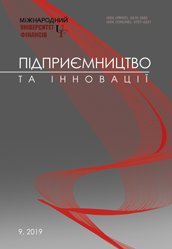FEATURES OF CREATING WATER TOURISM RECREATION CLUSTERS IN SUMY REGION
Abstract
The article reveals the necessity and expediency of socio-economic development of regions and territories of the united territorial communities of Ukraine at the present stage by means of tourism. In today's economic crisis, the cluster approach is of great importance to the business organizations in regions and territories of integrated territorial communities. The essence of the cluster approach to the territorial organization of management is highlighted and the ways of formation of tourist recreational clusters at the regional and local levels by means of active tourism are shown. The term "active tourism" is also interpreted as an active recreational recreation in the natural environment with the technologies of sports tourism. The types of active tourism that are currently popular in Ukraine are determined, and the nature and importance of water (rowing) tourism at the present stage of regional development of territories is spread. The term and structure of active water tourism are defined, as long-term or one-day journeys by water waters on various vessels: paddles, kayaks, rafts, floats, boats using the man's muscular power. A detailed description of the water resources of Sumy region as a basic basis for the development of active water tourism in the region and in the territories of the united territorial communities and the whole region. It is also noted that the creation of clusters of active water tourism at the level of the region and the territory of the UTC becomes an incentive for the development of regional and local tourism, enhancing the competitive advantages of the UTC region and the territory and, accordingly, the socio-economic development of the region. That is, during the creation and activity of tourist clusters, there are conditions in the territories of the united territorial communities for the formation of points of their economic growth, but at the present stage there are negative factors for the formation of recreational clusters of active water tourism in Sumy region, namely the absence of: a state unified strategist approach, regulatory framework for clustering, information support, public-private mechanism for the formation and activity of tourist clusters in Ukraine. The methodology of creation of tourist clusters covers stages and actions, and states that the formation and functioning of tourist clusters does not end at the stage of its implementation, but is carried out continuously in the format of correcting identified deficiencies, challenges and new conditions of economic activity. Nine points are identified that will stimulate the emergence of local clusters of active water tourism in the Sumy region and may become the locomotives for regional development of the tourism industry.
References
Porter M. Location, Competition and Economic Development: Local Clusters in a Global Economy. Economic Development Quarterly. 2000. Vol. 14. № 1. P. 15–34.
Michael E. Tourism Micro-clusters. Tourism Economics. 2003. Vol. 9. № 2, juin. Р. 133–145.
MCRAE-WILLIAMS P Wine and Tourism : Cluster Complementarity and Regional. 2004. Р. 123–128.
Курбатко О.В. Еколого-економічна конвергенція регіонів як напрям забезпечення сталого розвитку. Економічна наука. Серія «Економіка і держава». 2009. № 9(81). С. 45–47.
Пойтченко К.А. Кластери як фактор структурування економіки. Стратегія економічного розвитку України. 2001. Вип. 7. С. 623–628.
Федоренко С.Г., Тугай А.М., Гойко А.Ф. Концепція кластерної політики в Україні. Економічна наука. Серія «Економіка і держава». 2008. № 11. С. 5–15.
Дербчинська А.В. Розвиток активного туризму в Україні. Стан і тенденції розвитку туризму : матеріали III Всеукр. наук-практ. конф. Миколаїв : МФ КНУКІМ, 2015. С. 27–30.
Кальченко О.М. Кластеризація туристської галузі. Вісник ЧДТУ. Серія «Економічні науки». 2009. № 39. 186–195.
ДАВР України РОВР Сумської області. Водні ресурси Сумської області : вебсайт. URL : http://sumyvodres.davr.gov.ua/vodni-resursi/ (дата звернення: 04.02.2020).
Porter M. (2000). Location, Competition and Economic Development: Local Clusters in a Global Economy. Economic Development Quarterly, 14, 1, 15–34.
Michael E. (2003). Tourism Micro-clusters. Tourism Economics, 9, 2, 133-145.
Mcrae-Williams P. (2004). Wine and Tourism: Cluster Complementarity and Regional.
Kurbatko O.V. (2009). Ecological and economic convergence region yak right away secured by steel rosette [Ecological and economic convergence of regions as a direction for sustainable development]. Economical science. Ser. Economy and Power, 9 (81), 45-47.
Poytchenko K.A. (2001). Clusters are a factor in the structure of the economy [Clusters as a factor in structuring the economy]. Strategy for economical development of Ukraine, 7, 623-628.
Fedorenko S.G., Tugay A. M., Goiko A. F. (2008). The concept of cluster policy in Ukraine [The concept of cluster policy in Ukraine]. Economical science. Ser. Economy and power, 11, 5-15.
Derbchinska A.V. (2015). Development of active tourism in Ukraine [Development of active tourism in Ukraine]. Stan and tourism development tourism: materials III All-Ukrainian. practical sciences. conf. Mikolaev: VP "MF KNUKIM", 27-30.
Kalchenko O.M. (2009). Cluster tourism galuz [Clustering of the tourism industry]. Visnyk ChDTU. Ser. Econom. Science, 39, 186-195.
Davr Ukraine Rovr Sum. reg. Water Resources in Sumy Oblast: website. URL: http://sumyvodres.davr.gov.ua/vodni-resursi/ (date of beast: 02.04.2020).



